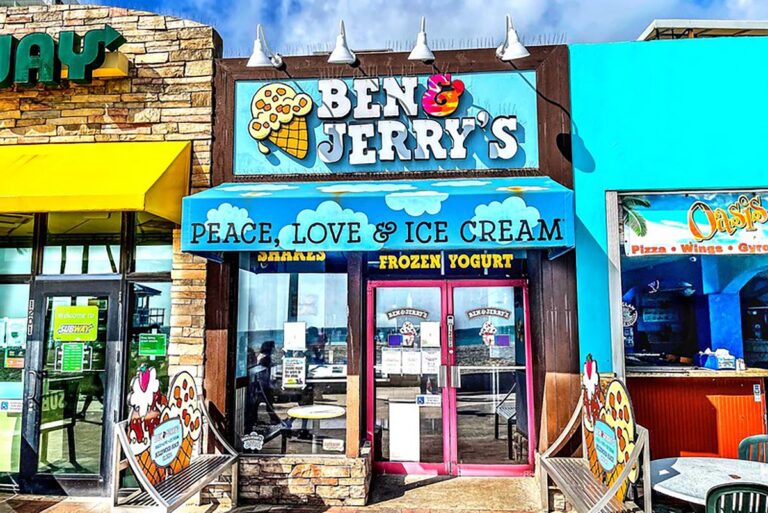
Editor’s note: This article is the third of a three-part series covering the untold Jewish histories of your favorite ice cream brands. Check out Part 1 on Häagen-Dazs and Part 2 on Baskin-Robbins.
How did two seventh-grade friends go on to build an ice cream empire fueled by activism — and eventually make international headlines with a controversial decision regarding sales in the West Bank?
Ben Cohen and Jerry Greenfield probably weren’t expecting that their friendship, formed when Greenfield fainted during gym class, would lead to a multi-billion dollar enterprise.
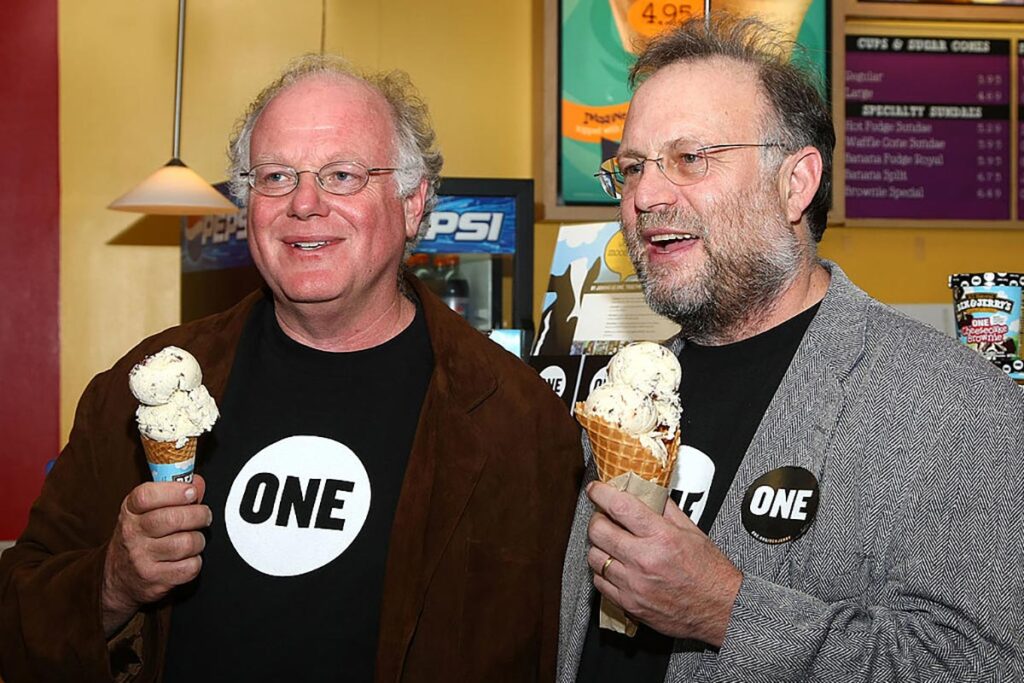
Growing up in Merrick, Long Island, Cohen and Greenfield attended Hebrew School together and had their bar mitzvahs at their local Reform synagogue. As the only students who couldn’t run a mile under seven minutes, the duo never strayed far from one another and built their business together as adults.
Let’s unpack the Jewish roots of Ben & Jerry’s and how they leveraged their platform to advocate for social change, prompting both support and criticism. Read below to learn about these entrepreneurs’ journey and the controversy surrounding their Israel policies.
Steve Herrell: The ice cream pioneer who inspired Ben & Jerry’s
To understand the story of Ben & Jerry’s, we first need to look at the work of fellow ice cream visionary, Steve Herrell.
Herrell, whose wife and business partner were Jewish, found himself intrigued by the ice cream innovation happening in New York City: In the 1960s, Häagen-Dazs was innovating with unique flavors such as rum raisin and boysenberry. Inspired by this approach, Herrell set out to further diversify the ice cream palette.
In 1973, he opened Steve’s, an eclectic ice cream parlor set in a converted dry-cleaners in Somerville, Massachusetts. Steve’s was known for its colorful, mismatched furniture, wide array of ice cream flavors like cookie dough and peanut butter, and signature “mix-ins” bar, where customers could choose toppings like M&Ms, Oreos, and Heath bars.
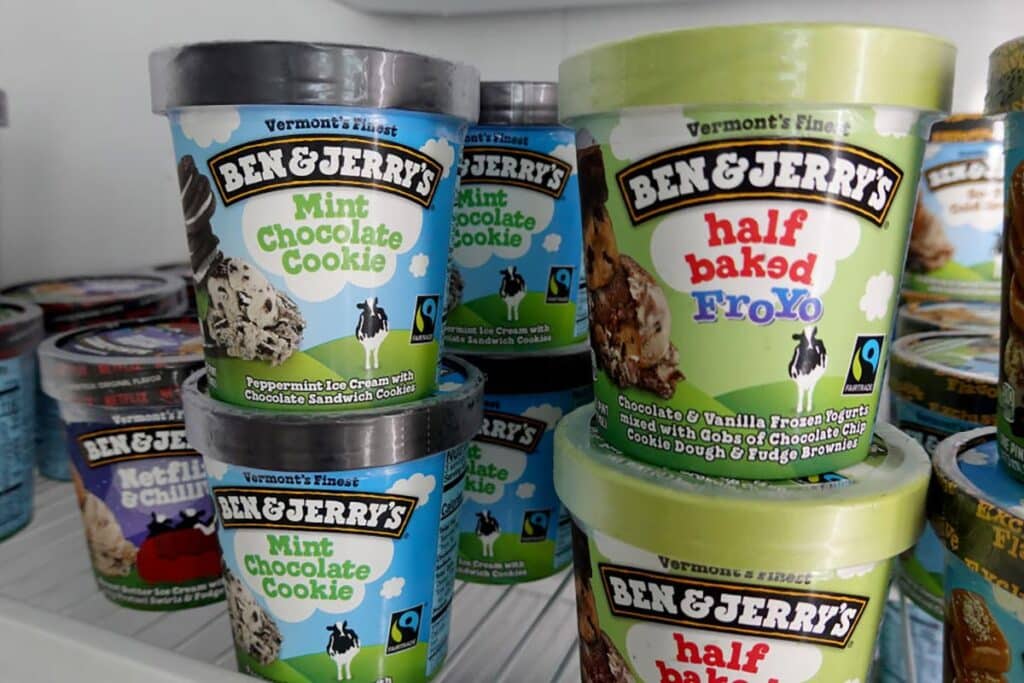
Cohen and Greenfield used Herrell’s whimsical ice cream shop atmosphere and the decadent experience of enjoying an elaborate ice cream cone as the model for their future stores.
After Greenfield was rejected from medical school twice, he and Cohen decided to open a food business together. Greenfield needed a Plan B to his medical school dreams, and he and Cohen thought it would be fun to run their own eatery.
“We were both fat, dumpy kids growing up, and we liked to eat. So we knew we wanted to do something with food,” Greenfield told the Washington Post. They initially thought of opening a bagel or fondue store, but opted for ice cream due to the high cost of bagel-making equipment. Plus, the rural college town location they wanted to make home didn’t have much of a bagel market.
“Eventually we realized that there weren’t that many people in rural college towns looking to have the Sunday New York Times and bagels, cream cheese and lox delivered to their door,” Cohen said.
Yet, there was a small glitch in their plan: Neither Greenfield nor Cohen knew anything about making ice cream. To address this, they each enrolled in a $5 ice cream-making class offered by Penn State. Both received an A in the course since the final exam was open book.
Steve Herrell’s success inadvertently led to Ben & Jerry’s
Cohen and Greenfield were inspired by Herrell’s pioneering “mix-in” ice cream and the individualized aspect of getting a custom cone with infinite options of flavors.
With a modest investment of $12,000, they opened their first ice cream shop in a refurbished gas station in Burlington, Vermont — the only college town they could find without an ice cream store. They shared the first location with a local produce farmer who wanted to sell his vegetables.
In addition, they decided to buy old restaurant equipment from going-out-of-business sales and auctions. With the equipment, Greenfield and Cohen sold the bizarre combination of soup, crepes, and pottery alongside the ice cream.
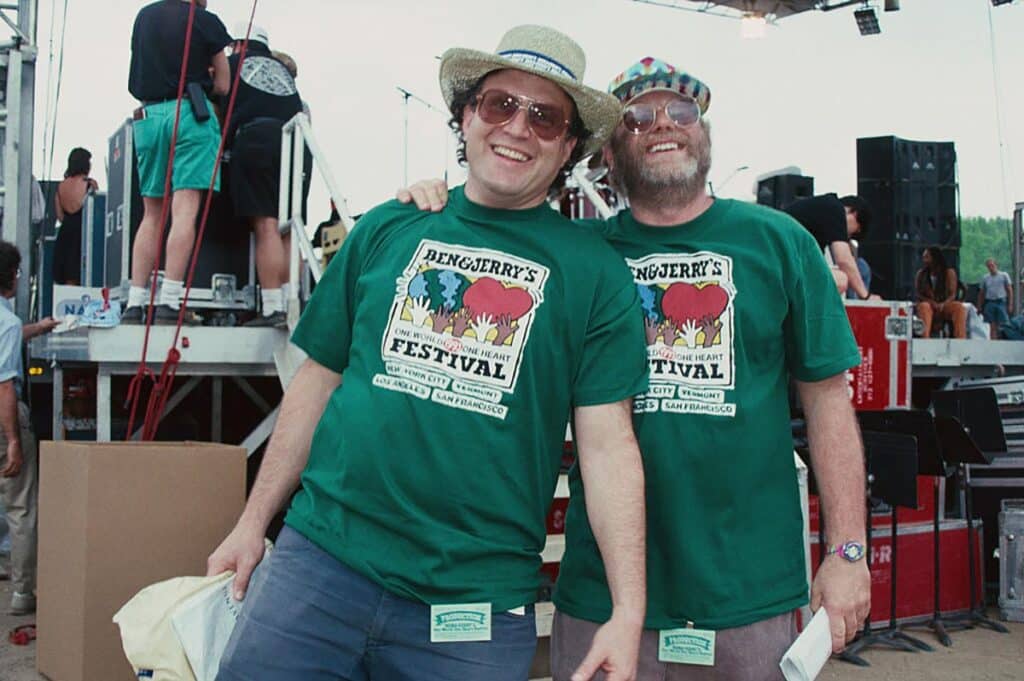
After finding a store location and buying equipment, Greenfield concentrated on ice cream production while Cohen handled marketing. To balance their roles, with Jerry Greenfield as CEO, they placed Ben Cohen’s name first in the company’s title.
Soon after setting up shop, Cohen and Greenfield realized that they couldn’t perfect Herrell’s method.
“At first we incorporated mix-ins; then we realized that we weren’t very good at it,” Greenfield recalled, adding that the duo struggled to fully integrate toppings into the ice cream using Herrell’s technique. “We muddled through for a while, and then we made flavored mix-ins like Oreo mint and vanilla Heath Bar crunch.”
At the time, the range of toppings and flavors at ice cream parlors was quite limited. If customers wanted flavors with unique textures or with mixed-in toppings and syrups, they had to seek out luxury brands.
However, the existing options were limited only to fruit flavors. The incorporation of mix-ins was still uncharted territory for many outlets, giving Ben & Jerry’s a distinct edge over their competitors.
Over time, this quirky duo from Vermont fine-tuned their technique, incorporating sweets and syrups directly into their ice cream using a mixer, unlike Steve’s folding-in method. This innovation led to iconic Ben & Jerry’s flavors like Phish Food, Chunky Monkey, and Cherry Garcia.
In their pursuit of differentiation and crafting a delightful product, the founders were also motivated to tailor their ice cream for Cohen. As a sufferer of anosmia, the inability to smell, Cohen wanted recipes that could be a sensory experience for him with his limited taste range.
“When we began, the game was for Jerry to make a flavor I could taste with my eyes closed. To do that he had to make ice creams that were intensely flavored,” Cohen said.
While running the business together, Cohen and Greenfield’s biggest disagreement was over the size of the chunks. Cohen advocated for a few large chunks in the ice cream while Greenfield was a proponent of a large number of smaller chunks.
Greenfield, the ice cream maker, argued that large chunks were harder to mix in — even today, most other ice cream companies don’t use them — and would create more work for him. However, Cohen eventually won out and the duo never looked back.
The chunkiness of Ben & Jerry’s innovated a practice which Greenfield termed “mining” in which ice cream lovers dig out the globs to eat. “Marriages have split because of that,” Cohen joked to the New York Times.

Their methods for achieving the perfect chunk size were both ingenious and highly unique. Take Greenfield’s technique, for instance: he’d hurl boxes of toffee from a ladder’s height to shatter them into the desired fragment sizes.
Their research strategies were unorthodox as well. Cohen, who managed quality control, delved into R&D by eating entire pints of ice cream. He was insistent that the entire container had a singular taste and texture, and needed to know he could vouch for the entire batch.
While the duo excelled in crafting and peddling ice cream, the financial intricacies of running a business posed hurdles. Even as Ben & Jerry’s gained popularity in Burlington and their creamy delights flew off the shelves, they grappled with inventory oversight, prudent budgeting, and making sure the bills were paid at the end of the month.
On one particularly challenging day, they were forced to close the shop to balance the books and pay bills, candidly noting for their patrons: “We’re closed because we’re trying to figure out what’s going on.”
Though the twosome might have been novices in the realm of business strategy, their robust sales kept them afloat. In 1979, to celebrate a year of business, they rolled out the now-legendary Free Cone Day, a gesture of gratitude to their loyal clientele. Not long after, they onboarded a COO to streamline the burgeoning business’ finances.
How Ben & Jerry’s set themselves apart
Unlike the Häagen-Dazs’ founders, who marketed their ice cream as a luxury, Cohen and Greenfield aimed for “an image of simple-down home wholesomeness” with their ice cream and stores.
Greenfield and Cohen wanted their store to feel like home to customers, to the point they even let customers lick the dashers — the spinning paddles of an ice cream maker — when a batch was done, like one would in their own home.
To get the word out about the business, Greenfield and Cohen drove their “cowmobile” cross country handing out free cones in 1986. The stores were brightly colored with cow memorabilia and cartoon-covered tables. Unlike the exotic map of Scandinavia that graced Häagen-Dazs’ cartons, Ben & Jerry’s designed bright cartons with images of the bushy-haired founders and cows.
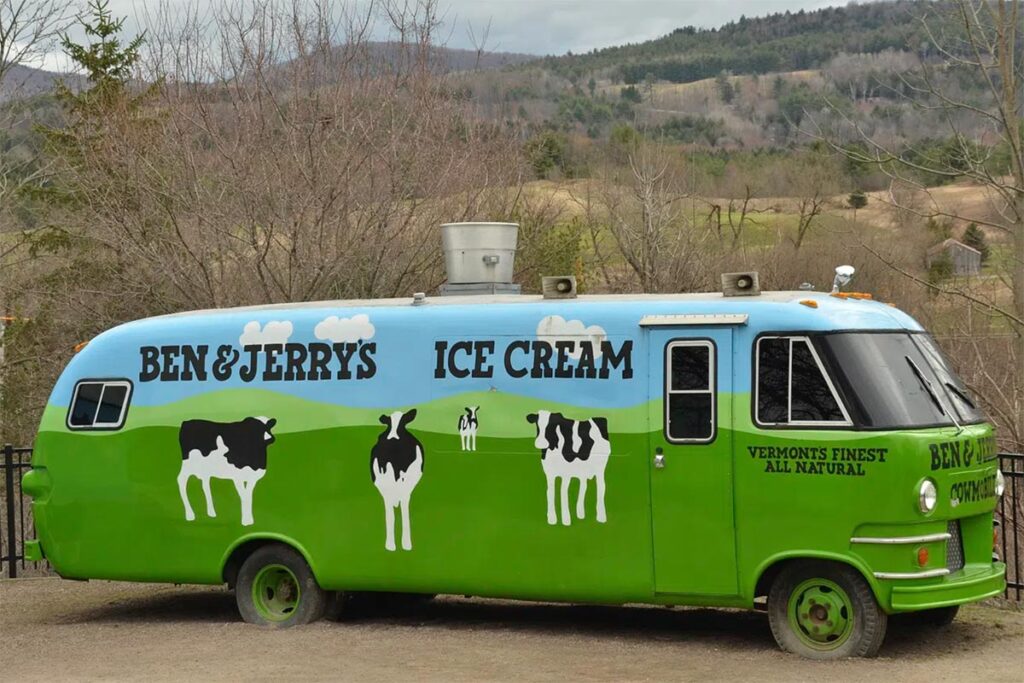
As the company grew and opened more stores, Ben & Jerry’s leaned in even more to their approachable and local nature. The founders wanted the company to remain locally-sourced — they continued to purchase milk from Vermont dairy farmers and turned to local artists to help design their stores, merchandise and packaging.

In 1985, when it became evident that the business needed more capital to grow, instead of working with venture capitalists, they sold 500,000 shares of the company to Vermont residents.
Meanwhile, gimmicks became a large part of the Ben & Jerry’s brand and a way for the founders to show off their personalities.
In 1983, the company donated 10 tons of ice cream to help a Vermont man build the world’s largest ice cream sundae.
This was one-upped in 1997 when the duo erected a physical flavor graveyard on a Vermont hill for flavors they discontinued, complete with granite headstones and epitaphs. In recent years, the company has even gone as far as to host funerals and burials for discontinued flavors.
However, the company’s biggest spectacle to date was its battle against Pillsbury.
Ben & Jerry’s became an ice cream empire through competition with its rival
As more companies began to stock Ben & Jerry’s, there was pushback from ice cream hegemons. In 1984, Pillsbury threatened to stop selling Haagen-Dazs to any Boston store that sold Ben & Jerry’s.
In response, Ben & Jerry’s began giving out buttons, shirts and bumper stickers that said, “What’s the doughboy afraid of?” They flew small planes around Boston’s sports stadiums and plastered local buses with ads showing the doughboy’s hands strangling a Ben & Jerry’s pint.
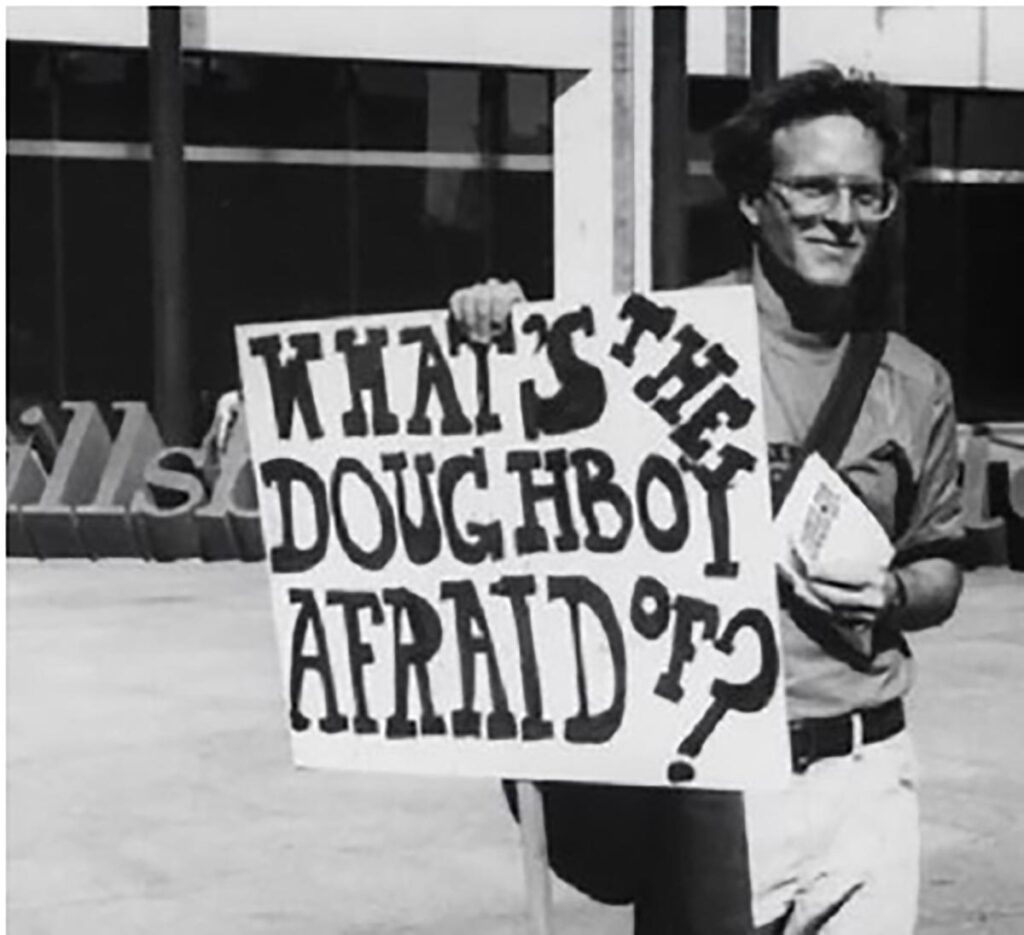
The company also included a phone number on their packaging and their free merchandise in which anyone who called received a recorded message about what Pillsbury was trying to do to Ben & Jerry’s.
“We started getting around a hundred calls a day on that line, mostly between midnight and 3 a.m. (apparently the time when people eat our product),” Cohen said in his book, “The Definition of Business.”
Soon, people couldn’t get enough of Ben & Jerry’s and their distinct flavors, and the first of many franchises was opened in 1981. By 1987, the company grossed $30 million with stores and wholesale sales in 35 states.
That year, entrepreneur Avi Zinger introduced the brand to Israel and the West Bank, marking its first international expansion. Ben & Jerry’s remains one of the top-selling ice cream brands in Israel today.
“We’d never even contemplated the possibility of selling ice cream outside the United States,” the founders wrote in their book, “Ben & Jerry’s Double Dip: How to Run a Values-Led Business, and Make Money, Too.”
In 1994, when Cohen stepped down as CEO, the company was worth $150 million.
In April 2000, Greenfield and Cohen sold Ben & Jerry’s to British food conglomerate Unilever. While Greenfield and Cohen are no longer involved in the management of the company, the duo still work for their brand as advisers to help shape its direction.
Ben & Jerry’s: A company built on social justice
As Ben & Jerry’s transitioned from a hometown gem to a global phenomenon, the brand became synonymous with fervently championing various social issues. Together, Cohen and Greenfield have faced arrest multiple times, notably while rallying against political funding influences and in solidarity with Wikileaks’ Julian Assange, to name a couple examples.
Their company has been outspoken on issues like the U.S. Supreme Court’s banning of affirmative action, systemic racism, and restrictions on abortion. It magnifies its perspectives through social media campaigns and even designs ice cream flavors where proceeds benefit various causes.
In a candid “Ask Me Anything” session on Reddit, Greenfield expressed their guiding principle this way: “Business should be using its power to help address social and environmental issues, and not just making money.”
Greenfield, who identifies as a “cultural Jew,” has said that his religious upbringing taught him to be a strong opponent of any kind of prejudice. The company’s social mission is “a really Jewish experience,” he said.
Annually, the company earmarks 7.5% of its pre-tax profits for the Ben & Jerry’s Foundation, bolstering grassroots movements that address prison reforms, racial equity, and economic disparities.
In addition, their flavors often mirror their advocacy.
In 2009, the beloved “Chubby Hubby” flavor donned the name “Hubby Hubby,” endorsing same-sex marriage rights.
In a defiant stand against former President Donald Trump‘s positions on matters like immigration, LGBTQ rights, and environmental conservation, 2018 saw the introduction of “Pecan Resist.” The flavor’s proceeds supported organizations like Color of Change, Honor the Earth, Women’s March, and Neta.
Today, all of Ben & Jerry’s flavors bear a kosher certification. And while bacon often tops their flavor request list, the company, as stated on their website, remains resolute in excluding it from their creamy concoctions.
Ben & Jerry’s Israel policies have sparked criticism
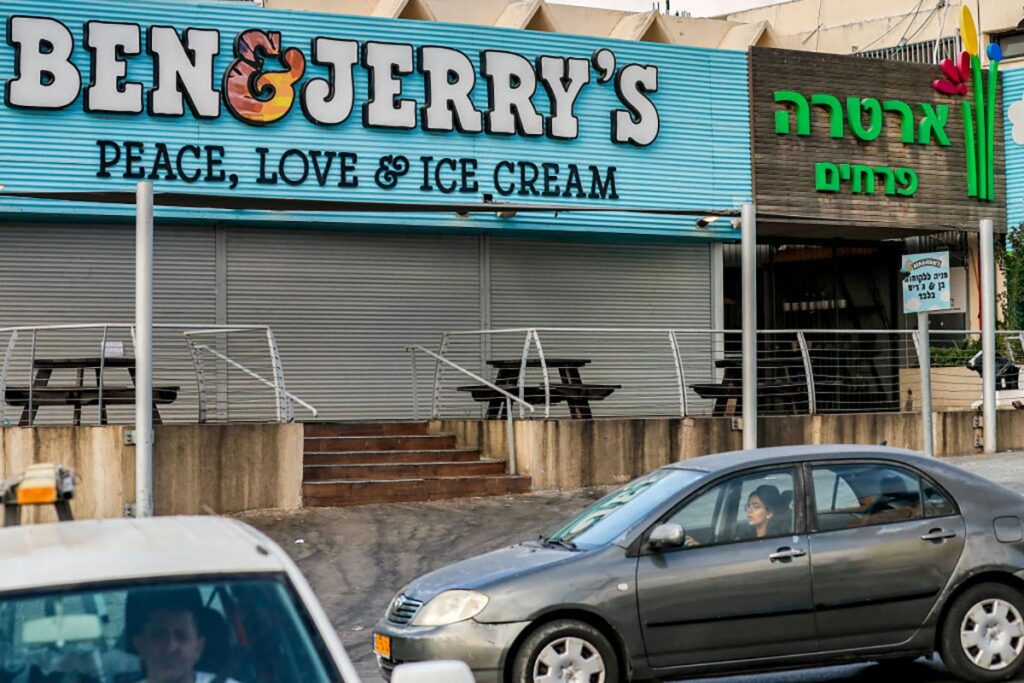
Why has Ben & Jerry’s become so successful? In a 2020 interview with the New York Times, Greenfield attributed it to three factors: high-quality ice cream using natural ingredients, unusual flavors, and the brand’s social activism.
“Some other company could start making ice cream with big chunks the same way Ben & Jerry’s does, but Ben & Jerry’s having this activist, outspoken social mission — other companies can’t copy that. It’s not something you can just say. It has to be who the people are,” he said.
But not everyone agrees with the company’s activist positions. In 1998, Ben & Jerry’s faced pushback when it announced it would no longer purchase water from an Israeli company in the Golan Heights because of what the board deemed an illegal occupation.
In 2021, the company made international headlines for its Israel policies again, when its board decided to halt ice cream sales in the West Bank.
Responding to the criticism, Greenfield and Cohen defended the move in a New York Times op-ed, adding that they are “proud Jews” and supporters of Israel. The founders argued that they are able to both “support Israel and oppose some of its policies,” just as they publically have in their criticism of the U.S.
“We see the company’s recent action as part of a similar trajectory — not as anti-Israel, but as part of a long history of being pro-peace,” they wrote.
The move was praised by the BDS (Boycott, Divest, Sanctions) movement against Israel and Palestinian activist groups, but it was widely criticized by the Jewish community.
Following Ben & Jerry’s pulling out of the West Bank, Cohen told an Axios reporter: “We hugely support Israel’s right to exist but we are against a particular policy.”
In response to the accusations of antisemitism, he retorted that “it’s absurd. What, I’m anti-Jewish? I’m a Jew. My family is Jewish. My friends are Jewish.”
Meanwhile, Palestinians had a range of reactions to the news. Bassem Eid, a Palestinian peace advocate who lives in Israel, wrote in a Times of Israel op-ed: “Ben and Jerry’s decision to withdraw from the West Bank is nothing but performative activism, failing to help Palestinians in any meaningful way. In fact, it is actively harming us in the process.” Eid added that Ben and Jerry’s decision would lead to the loss of high-paying delivery and farming jobs for Palestinian workers.
Originally Published Oct 4, 2023 12:17PM EDT


